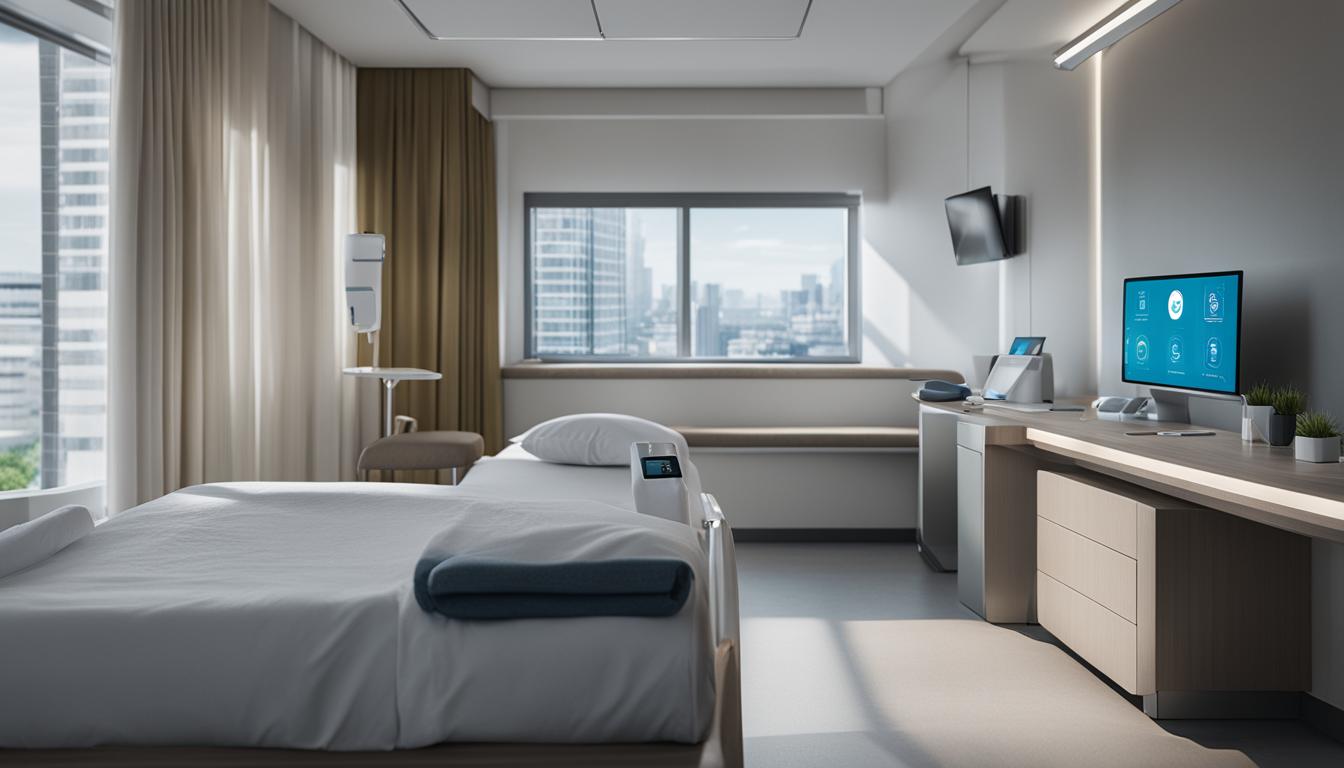The integration of IoT technology into healthcare systems is revolutionizing patient care, treatment processes, and medical research. IoT refers to the network of interconnected physical devices embedded with sensors, software, and network connectivity. In healthcare, IoT is enabling the collection and analysis of vast amounts of patient data, promoting remote monitoring, and enhancing the efficiency of medical facilities.
Key Takeaways:
- IoT is transforming healthcare by facilitating remote monitoring and analysis of patient data.
- Smart healthcare systems powered by IoT technology enhance the efficiency of medical facilities and promote personalized treatment.
- Healthcare data analytics help in making informed decisions for improved patient outcomes and healthcare digital transformation.
- IoT solutions for healthcare enable remote patient monitoring, telemedicine, and optimized clinical workflows.
- The future of IoT in healthcare holds promise for artificial intelligence integration, wearable health tech, 5G connectivity, and blockchain technology.
Key Applications of IoT in Healthcare
The integration of IoT technology in healthcare has resulted in various applications that are transforming the way healthcare is delivered. Through the use of remote patient monitoring, smart medical devices, telemedicine, asset and inventory management, clinical workflow optimization, hospital and home automation, and drug management and compliance, IoT is revolutionizing patient care and improving healthcare outcomes.
- Remote Patient Monitoring: IoT enables healthcare providers to remotely monitor patients’ vital signs and health parameters in real-time. This allows for timely interventions and proactive care management.
- Smart Medical Devices: Connected devices, such as smart inhalers and intelligent pill dispensers, enhance patient management by improving medication adherence and tracking patient behavior.
- Telemedicine: IoT facilitates remote medical consultations, reducing the need for in-person visits and improving healthcare access.
- Asset and Inventory Management: IoT improves the management of medical equipment and supplies, ensuring their availability when needed and optimizing resource allocation.
- Clinical Workflow Optimization: IoT connects various systems and devices, streamlining healthcare processes and reducing errors. Integration with electronic health records enhances data exchange and decision-making.
- Hospital and Home Automation: IoT-based automation systems improve infrastructure management in hospitals and support independent living for patients at home.
- Drug Management and Compliance: IoT enables better drug management by ensuring medication adherence and monitoring storage conditions, leading to improved patient safety and compliance with healthcare regulations.
These applications of IoT in healthcare are transforming the way healthcare is delivered, leading to improved patient outcomes, enhanced efficiency, and personalized care.
Benefits of IoT in Healthcare
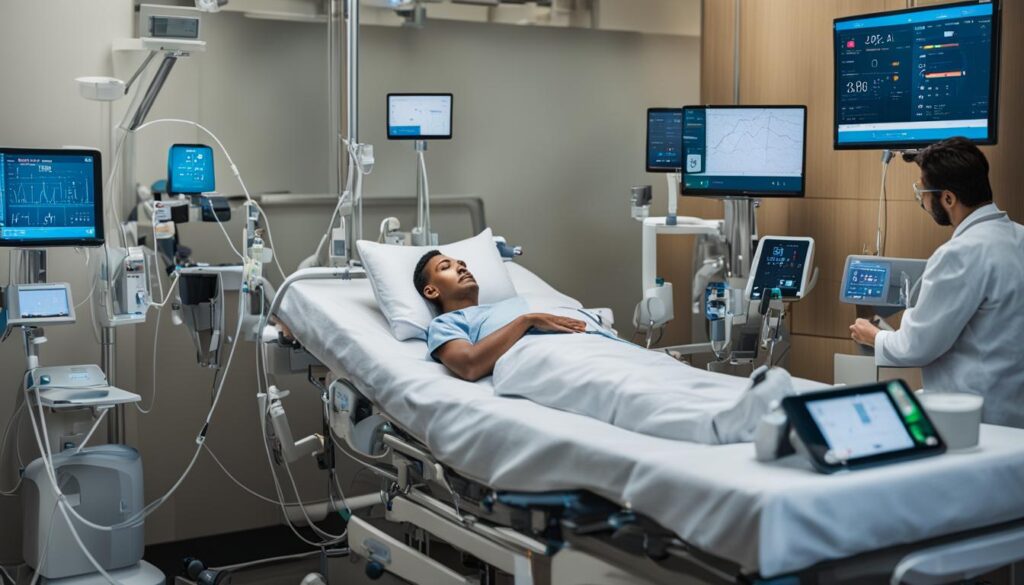
The integration of IoT in healthcare offers numerous benefits that significantly improve patient care and enhance overall efficiency in medical facilities. IoT enables remote monitoring, timely intervention, and personalized treatment plans, resulting in improved patient outcomes. By automating processes and reducing errors, IoT enhances efficiency and streamlines healthcare workflows. Additionally, IoT in healthcare leads to cost savings by preventing hospital readmissions and complications. The implementation of telemedicine and remote monitoring through IoT increases accessibility to healthcare services, particularly for patients in remote or underserved areas. Continuous monitoring and adjustment of regimens in real-time allow for personalized treatment plans tailored to each patient’s unique needs.
Improved Patient Outcomes through Remote Monitoring
IoT enables healthcare providers to remotely monitor patients’ vital signs and health parameters in real-time, leading to improved patient outcomes.
With IoT devices collecting and transmitting data, healthcare professionals can detect any deviations or abnormalities promptly and intervene timely. By continuously monitoring patients, healthcare providers can identify potential health risks and prevent medical emergencies. This remote monitoring capability enables early intervention, reducing the likelihood of complications and hospital readmissions.
Enhanced Efficiency and Error Reduction
IoT automates processes and reduces errors, enhancing overall efficiency in healthcare facilities.
By integrating IoT devices and systems, healthcare workflows become more streamlined and automated. Tasks that were previously manual and time-consuming can now be efficiently handled through IoT technology. This automation reduces the risk of errors and frees up healthcare professionals’ time, allowing them to focus on providing quality care to patients. As a result, healthcare facilities can operate more efficiently, improving the overall patient experience.
Cost Savings through Prevention and Efficiency
IoT in healthcare contributes to cost savings by preventing hospital readmissions and complications.
Through remote monitoring and timely intervention, IoT helps prevent adverse health events that may lead to hospital readmissions. By detecting potential issues early on, healthcare providers can intervene proactively, saving healthcare costs associated with emergency treatments or unplanned hospital stays. Additionally, the automation and efficiency enhancements brought by IoT technology reduce administrative workload, enabling healthcare professionals to utilize their time more effectively and reducing operational costs.
Increased Accessibility through Telemedicine and Remote Monitoring
IoT enables telemedicine and remote monitoring, increasing accessibility to healthcare services.
Thanks to IoT, patients in remote or underserved areas can access healthcare services through telemedicine. They can consult with healthcare professionals remotely, eliminating the need for long-distance travel and minimizing barriers to care. Similarly, remote monitoring allows patients to receive medical attention and interventions without physically visiting healthcare facilities. This increased accessibility improves patient convenience and enables timely healthcare interventions, regardless of geographical location.
Personalized Treatment Plans based on Continuous Monitoring
Continuous monitoring and adjustment of regimens facilitated by IoT allow for personalized treatment plans.
IoT technology enables healthcare providers to continuously monitor patients’ health parameters and make real-time adjustments to treatment plans. By obtaining up-to-date and accurate data, healthcare professionals can tailor treatment regimens to each patient’s specific needs. This personalized approach improves treatment effectiveness, reduces adverse effects, and promotes optimal patient outcomes.
Overall, the integration of IoT in healthcare brings forth improved patient outcomes, enhanced efficiency, cost savings, increased accessibility, and personalized treatment plans. With continuous advancements in IoT technology and its integration into healthcare systems, the potential to transform the healthcare industry and deliver patient-centric care is immense.
Challenges and Considerations of IoT in Healthcare
While the integration of IoT in healthcare brings significant benefits, it also presents several challenges and considerations that need to be addressed. These factors can impact the successful implementation and utilization of IoT solutions in the healthcare industry.
Data Security and Privacy
One of the most crucial considerations when implementing IoT in healthcare is ensuring data security and privacy. Healthcare data is highly sensitive and must be protected from unauthorized access, breaches, and cyber threats. Robust security measures, such as encryption, authentication, and access controls, are essential to safeguard patient information and maintain trust in IoT-enabled healthcare systems.
Interoperability
Interoperability refers to the seamless exchange of data between different IoT devices and systems. In the healthcare context, interoperability is crucial for healthcare providers to access and utilize patient data across various devices and platforms. Standardized protocols and data formats are necessary to ensure compatibility and interoperability between different IoT devices, enabling efficient data sharing and utilization.
Regulatory Compliance
Healthcare IoT solutions must comply with regulatory requirements, such as the Health Insurance Portability and Accountability Act (HIPAA) in the United States. These regulations govern the privacy and security of healthcare data, dictating how patient information should be collected, stored, and transmitted. Adhering to these regulations is essential to protect patient privacy and avoid potential legal consequences.
Data Overload
The vast amount of data generated by IoT devices in healthcare can lead to data overload. Collecting and analyzing such a large volume of data can be overwhelming without effective management and analysis tools. Healthcare organizations must develop robust data management strategies and utilize advanced analytics techniques to extract meaningful insights from IoT-generated data.
Resistance to Change
Resistance to change can hinder the successful implementation of IoT in healthcare. It can stem from various factors, including concerns about job security, unfamiliarity with new technologies, or apprehension about the impact on existing workflows and processes. Healthcare organizations must actively address these concerns through proper change management strategies, training programs, and clear communication to encourage acceptance and adoption of IoT solutions.
Overcoming these challenges and considerations is crucial for the effective deployment and utilization of IoT in healthcare. By addressing data security and privacy concerns, ensuring interoperability, complying with regulations, managing data overload, and actively managing resistance to change, healthcare organizations can harness the potential of IoT to improve patient care, enhance operational efficiency, and drive healthcare innovation.
The Future of IoT in Healthcare
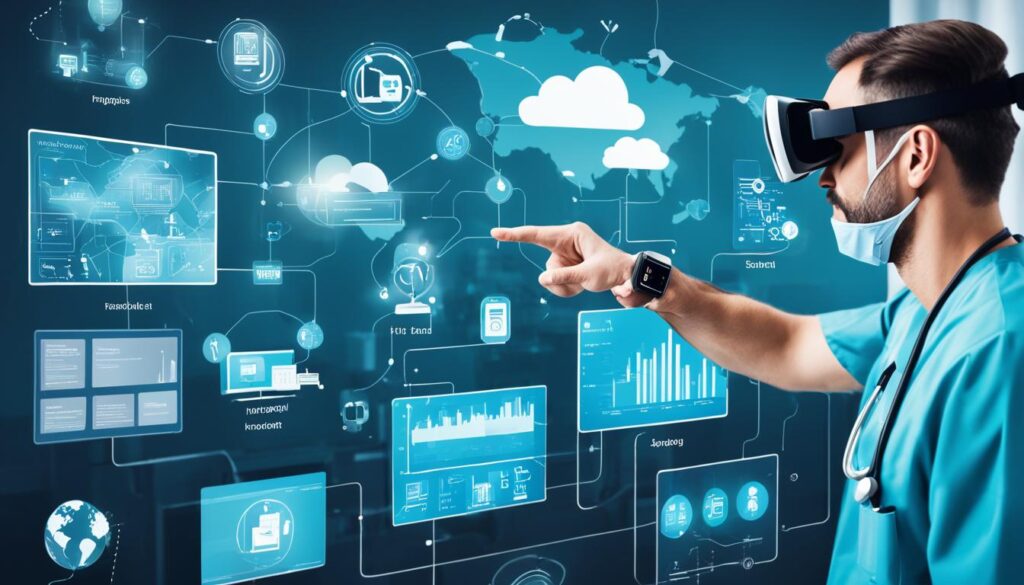
The rapid advancements in IoT technology are shaping the future of healthcare. Several key trends are expected to drive the integration of IoT into healthcare systems, empowering healthcare providers and improving patient outcomes. Let’s explore the exciting possibilities that lie ahead.
Integration with Artificial Intelligence
One of the most significant developments in IoT healthcare is the integration of artificial intelligence (AI). As AI continues to evolve, it will enable advanced analysis of the vast amount of patient data collected by IoT devices. By leveraging AI algorithms, healthcare providers will gain deeper insights into patient conditions, enabling more accurate diagnoses, personalized treatment plans, and proactive interventions. AI integration will revolutionize medical research, paving the way for breakthroughs in disease prevention and treatment.
Advancements in Wearable Health Tech
Wearable health tech has already made its mark in the healthcare industry, but its potential is far from exhausted. Future advancements in wearable devices will offer more sophisticated monitoring capabilities and lifestyle recommendations. These devices will empower individuals to take greater control of their health by continuously tracking vital signs, activity levels, sleep patterns, and more. With the ability to provide real-time data and actionable insights, wearable health tech will enable early intervention, preventive care, and disease management.
5G Connectivity for Seamless Communication
The rollout of 5G connectivity will revolutionize IoT in healthcare by offering faster and more reliable communication between devices. With increased network speeds and low latency, healthcare providers will have real-time access to patient data, enabling remote monitoring, telemedicine consultations, and timely interventions. 5G connectivity will also support the growing demand for precision medicine, where healthcare decisions and treatments are tailored to an individual’s unique genetic makeup and lifestyle factors.
Enhanced Data Security with Blockchain Technology
Data security and integrity are critical in healthcare, and blockchain technology can play a vital role in ensuring patient privacy and data protection. By employing decentralized and transparent data storage, blockchain technology can enhance the security of healthcare data, preventing unauthorized access and tampering. This technology enables secure sharing of medical records, seamless interoperability between healthcare providers, and streamlined insurance processes. Implementing blockchain in IoT healthcare systems will foster trust in data integrity and compliance with regulatory requirements.
Expanding Telehealth and Remote Monitoring
The COVID-19 pandemic has accelerated the adoption of telehealth and remote monitoring, and this trend is set to continue. With the integration of IoT, telehealth will expand further, providing increased access to healthcare services, especially for individuals in remote or underserved areas. Remote monitoring through IoT devices will enable continuous patient monitoring, early detection of health issues, and proactive interventions. This approach not only improves patient outcomes but also reduces the strain on healthcare facilities by minimizing in-person visits.
As healthcare continues to embrace IoT technologies, artificial intelligence integration, wearable health tech, 5G connectivity, blockchain technology, and the expansion of telehealth will shape the future of healthcare delivery. These advancements will elevate patient care, facilitate proactive interventions, and revolutionize medical research, ultimately improving the quality of life for individuals worldwide.
Remote Patient Monitoring and IoT
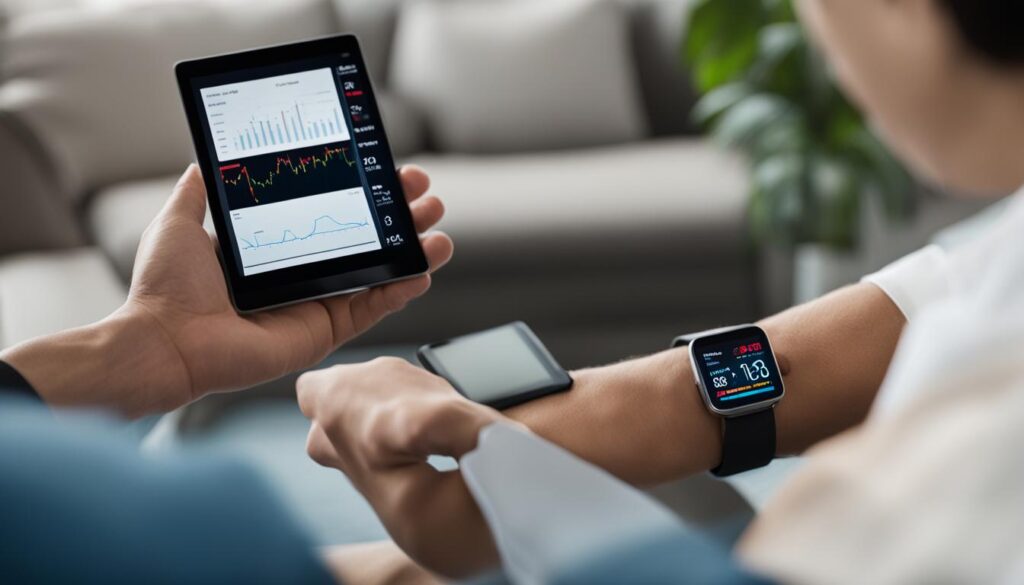
Remote patient monitoring is revolutionizing healthcare with the help of IoT technology. By utilizing wearable devices embedded with sensors, healthcare providers can collect real-time data on vital signs and health parameters, enabling timely care and intervention for patients.
Patients with chronic conditions greatly benefit from remote patient monitoring. Continuous monitoring of their health allows healthcare providers to detect any changes or abnormalities promptly, ensuring timely intervention and preventing exacerbation of their condition.
Wearable devices play a crucial role in remote patient monitoring. These devices, such as smartwatches, fitness trackers, and medical sensors, are capable of collecting and transmitting real-time data to healthcare professionals. This data includes measurements like heart rate, blood pressure, blood glucose levels, and oxygen saturation.
The ability to monitor patients remotely and in real-time empowers healthcare providers to deliver personalized and targeted care. By analyzing the data received from wearable devices, healthcare professionals can make informed decisions about treatment plans and medication adjustments, ultimately improving patient outcomes.
One of the key advantages of remote patient monitoring is its ability to reduce hospital readmissions. By closely monitoring patients’ health conditions, healthcare providers can detect any signs of deterioration early on and intervene before the condition worsens. This proactive approach helps prevent complications and unnecessary hospitalizations, resulting in cost savings for both patients and healthcare systems.
Furthermore, remote patient monitoring enhances the patient experience by reducing the need for frequent in-person visits. Patients can manage their health from the comfort of their own homes while still receiving high-quality care. This convenience and flexibility contribute to improved patient satisfaction and engagement in their healthcare journey.
Remote patient monitoring, enabled by wearable devices and IoT technology, offers a transformative approach to healthcare delivery. It provides healthcare professionals with real-time data, allowing them to intervene promptly and provide timely care to patients, particularly those with chronic conditions.
As the healthcare landscape continues to evolve, remote patient monitoring will play a crucial role in enhancing patient care and outcomes. The integration of wearable devices and IoT technology enables healthcare providers to monitor patients remotely, provide timely interventions, and deliver personalized care plans. With the power of real-time data, healthcare professionals can make informed decisions and ultimately improve the quality of care for patients with chronic conditions.
Smart Medical Devices and IoT
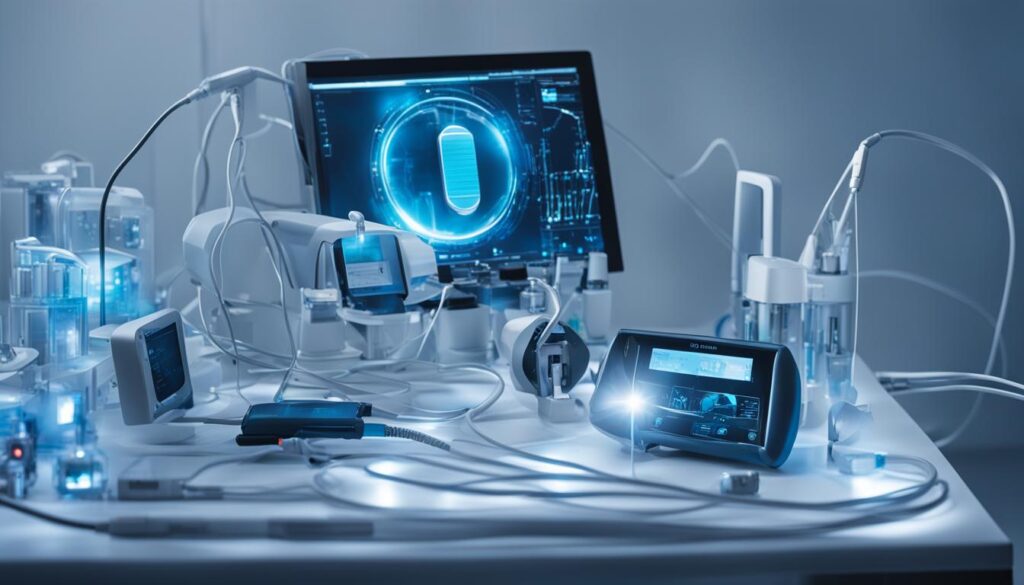
With the advent of IoT, the healthcare industry has witnessed the emergence of smart medical devices that are revolutionizing medication management and enhancing healthcare compliance. These innovative devices, such as connected inhalers and intelligent pill dispensers, are empowering patients to take control of their health and adhere to their medication regimens.
Smart medical devices play a crucial role in improving medication adherence, which is a significant challenge in healthcare. These devices offer features like medication reminders, dosage tracking, and real-time consumption monitoring. By providing timely reminders and tracking medication intake, smart medical devices help patients stay on track with their treatment plans, resulting in improved health outcomes.
In addition to aiding patients, smart medical devices also benefit healthcare providers and promote healthcare compliance. These devices enable healthcare professionals to remotely monitor patient compliance and gain valuable insights into medication adherence. By having access to real-time data, healthcare providers can identify non-adherent behavior, intervene when necessary, and tailor treatment plans accordingly.
“Smart medical devices are empowering patients to take an active role in managing their health and adhering to their medication regimens. These devices offer valuable features like medication reminders and real-time consumption tracking, enhancing medication management and ultimately improving patient outcomes.”
Benefits of Smart Medical Devices and IoT:
- Promote medication adherence and improve patient outcomes
- Enable real-time monitoring of medication consumption
- Provide medication reminders and personalized treatment plans
- Facilitate remote patient monitoring and timely intervention
- Enhance healthcare compliance and medication management
Case Study: Connected Inhalers
One example of a smart medical device is a connected inhaler designed for asthma patients. These inhalers are equipped with sensors that detect and record inhalation events. The data is then transmitted to a mobile app or cloud platform, allowing patients and healthcare providers to monitor inhaler usage patterns and identify potential adherence issues. By identifying adherence challenges early on, healthcare providers can intervene and provide necessary support to ensure optimal asthma management.
| Benefits of Connected Inhalers: | Key Features: |
|---|---|
| Improved asthma management and reduced exacerbations | – Sensors to detect inhalation events |
| Real-time monitoring of medication usage | – Data transmission to mobile app or cloud platform |
| Timely intervention for non-adherence | – Adherence alerts and reminders |
| Personalized treatment plans based on inhaler usage data | – Inhaler usage patterns analysis |
The integration of smart medical devices with IoT has transformed medication management and healthcare compliance. These devices empower patients, enable remote monitoring, and provide healthcare providers with valuable insights to enhance patient care. With further advancements in IoT technology, the future of smart medical devices looks promising, offering new possibilities for personalized and patient-centric healthcare.
Telemedicine and IoT
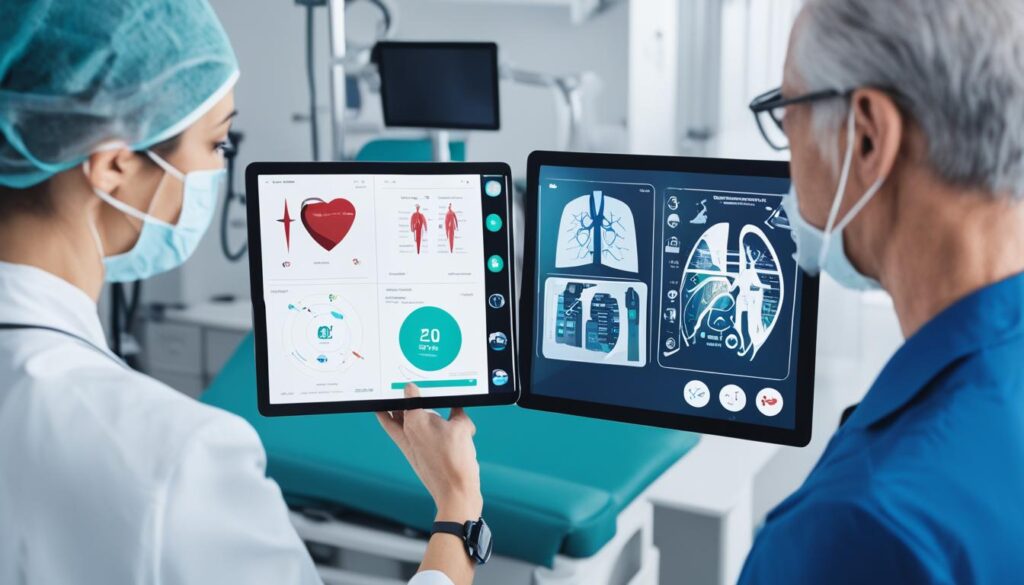
Telemedicine, a rapidly growing field in healthcare, has been significantly enhanced by the integration of IoT technology. By leveraging the power of interconnected devices, telemedicine enables remote medical consultations, bringing healthcare access directly to patients’ fingertips. This innovative approach reduces the need for in-person visits, improving convenience and minimizing the burden on healthcare facilities.
One of the key advantages of telemedicine is its ability to bridge the gap in healthcare access, particularly in underserved or remote areas. Patients who previously faced challenges in accessing specialized care can now connect with healthcare providers from the comfort of their own homes. This not only enhances the convenience for patients but also ensures that healthcare services reach populations that may have otherwise struggled to receive timely and appropriate care.
Furthermore, telemedicine reduces the burden on healthcare facilities by streamlining the consultation process. With the aid of IoT devices, patients can provide accurate real-time data, enabling healthcare providers to make informed decisions remotely. This reduces the number of unnecessary visits to healthcare facilities, optimizing the allocation of resources and freeing up valuable time for both patients and healthcare professionals.
To illustrate the potential impact of telemedicine and IoT, consider the following scenario:
A patient living in a remote area has been experiencing concerning symptoms. In the past, they would face significant challenges in accessing medical care due to the distance and limited availability of specialists in the area. However, with the advent of telemedicine and IoT, the patient can now schedule a remote consultation with a specialist. Through the use of connected devices, such as wearables and remote monitoring devices, the specialist can collect real-time data about the patient’s condition. They can then provide a diagnosis and treatment plan without the need for the patient to travel long distances for an in-person visit. This not only improves the patient’s access to care but also reduces the burden on healthcare facilities, allowing them to allocate resources more efficiently.
Overall, telemedicine fueled by IoT technology holds immense potential in transforming healthcare delivery. It enhances healthcare access, reduces the burden on both patients and healthcare facilities, and ultimately leads to improved patient outcomes. As technology continues to advance, the possibilities for telemedicine and IoT in revolutionizing healthcare are boundless.
Asset and Inventory Management with IoT
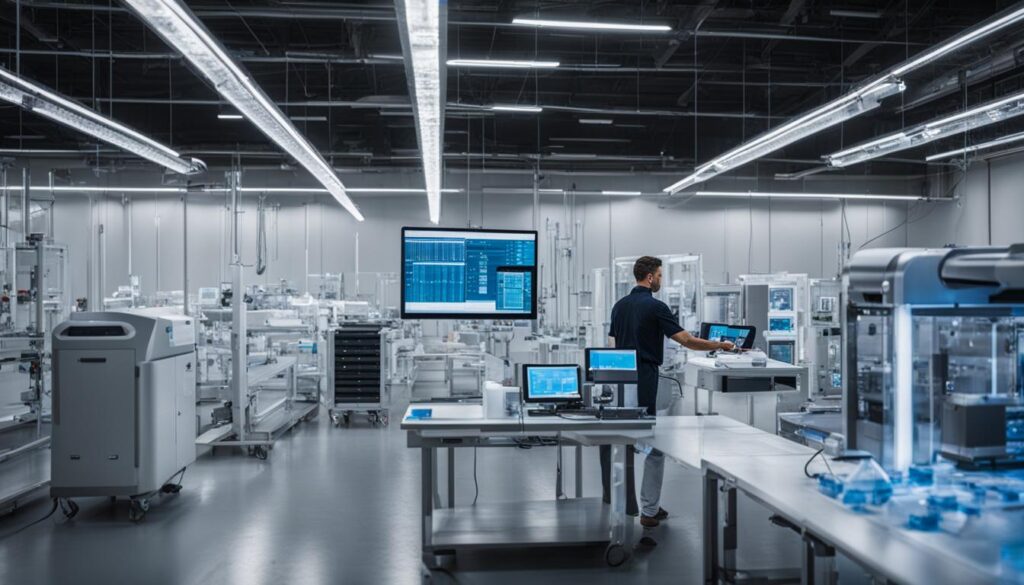
IoT technology plays a crucial role in improving asset and inventory management in the healthcare industry. By utilizing sensors and connectivity, medical facilities can track the location and condition of their equipment and supplies in real-time. This ensures that the necessary medical devices are readily available when needed, reducing the risk of delays in patient care.
One of the key advantages of asset and inventory management with IoT is the ability to achieve significant cost savings. By accurately tracking inventory levels and optimizing resource allocation, healthcare facilities can avoid overstocking or shortages, leading to more efficient utilization of resources. This not only reduces unnecessary expenses but also minimizes waste and ensures that the right equipment is in the right place at the right time.
Efficient resource allocation is another important benefit of IoT in asset and inventory management. By monitoring the usage patterns and performance of medical equipment, healthcare facilities can identify opportunities for optimization. This data-driven approach enables informed decision-making regarding equipment maintenance, replacement, and upgrades, resulting in improved resource allocation and operational efficiency.
Implementing asset and inventory management with IoT offers numerous advantages, including:
- Real-time monitoring and tracking of medical equipment
- Improved availability of medical devices when needed
- Cost savings through optimized inventory management
- Efficient resource allocation based on data-driven insights
“IoT in asset and inventory management enables healthcare facilities to better track and manage their valuable resources, leading to cost savings and more efficient operations.”
By harnessing the power of IoT, healthcare providers can enhance their asset and inventory management practices, ensuring seamless operations, and ultimately delivering better patient care.
Clinical Workflow Optimization with IoT
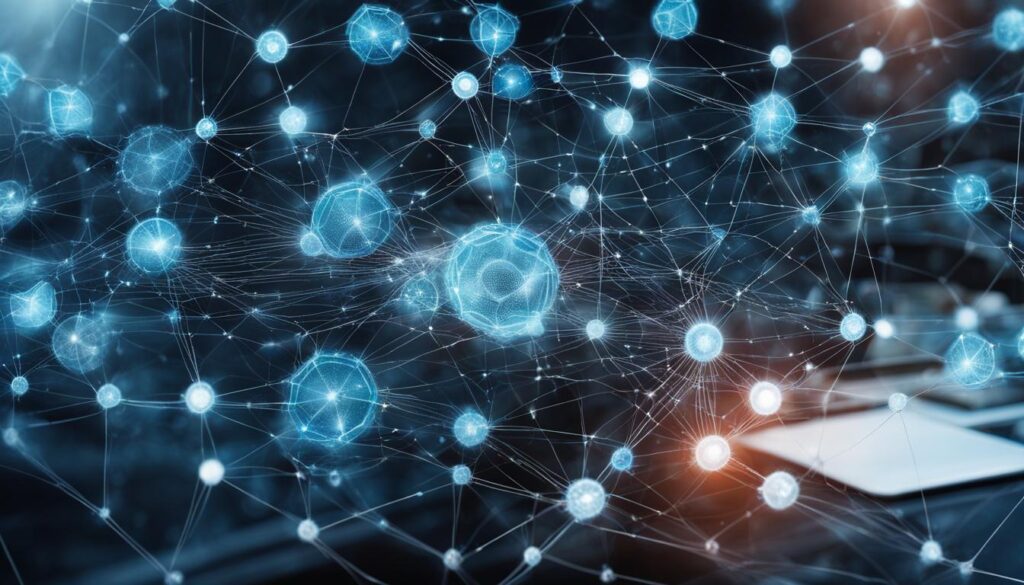
Optimizing clinical workflows is essential for improving efficiency, accuracy, and reducing administrative burden in healthcare settings. With the integration of IoT technology, clinical workflow optimization has become even more seamless and effective.
One key aspect of clinical workflow optimization is the seamless integration of electronic health records (EHRs) with diagnostic equipment. This integration allows for automated data transfer, eliminating the need for manual entry and reducing the risk of errors. By connecting EHRs and diagnostic devices, healthcare providers can access patient data in real-time, leading to improved decision-making and timely interventions.
“The integration of IoT in clinical workflows has revolutionized the way healthcare professionals access and utilize patient data. The ability to automatically transfer information from electronic health records to diagnostic devices has significantly reduced errors and improved the overall quality of care.” – Dr. Emma Anderson, Chief Medical Officer at XYZ Hospital
In addition to data transfer, IoT technology enables the use of smart devices and sensors that streamline various processes within the clinical workflow. For example, wearable devices can continuously monitor patients’ vital signs and transmit real-time data to healthcare providers. This allows for remote patient monitoring, early detection of abnormalities, and timely intervention for improved patient outcomes.
Moreover, IoT facilitates efficient communication and collaboration among healthcare professionals, enhancing the coordination of care. Real-time updates on patient conditions, treatment plans, and medication schedules can be shared securely, reducing the risk of miscommunication and ensuring consistent and effective care delivery.
“The integration of IoT in clinical workflow optimization has transformed the way healthcare teams collaborate. Real-time access to patient information and seamless communication between providers lead to improved coordination and ultimately better patient outcomes.” – Dr. Michael Johnson, Chief Medical Informatics Officer at ABC Medical Center
The benefits of clinical workflow optimization with IoT extend beyond patient care. With streamlined processes and reduced manual tasks, healthcare professionals can devote more time and attention to direct patient interactions, fostering stronger patient-provider relationships and promoting patient-centered care.
In summary, the integration of IoT technology in clinical workflow optimization has revolutionized healthcare by automating data transfer, reducing errors, and enhancing collaboration among healthcare professionals. By leveraging the power of IoT, healthcare facilities can improve efficiency, accuracy, and ultimately provide better care to patients.
| Benefits of Clinical Workflow Optimization with IoT |
|---|
| Automated data transfer between electronic health records and diagnostic equipment |
| Real-time access to patient data for improved decision-making |
| Remote patient monitoring and early detection of abnormalities |
| Efficient communication and collaboration among healthcare professionals |
| Enhanced coordination of care and patient-centered approach |
IoT in Hospital and Home Automation
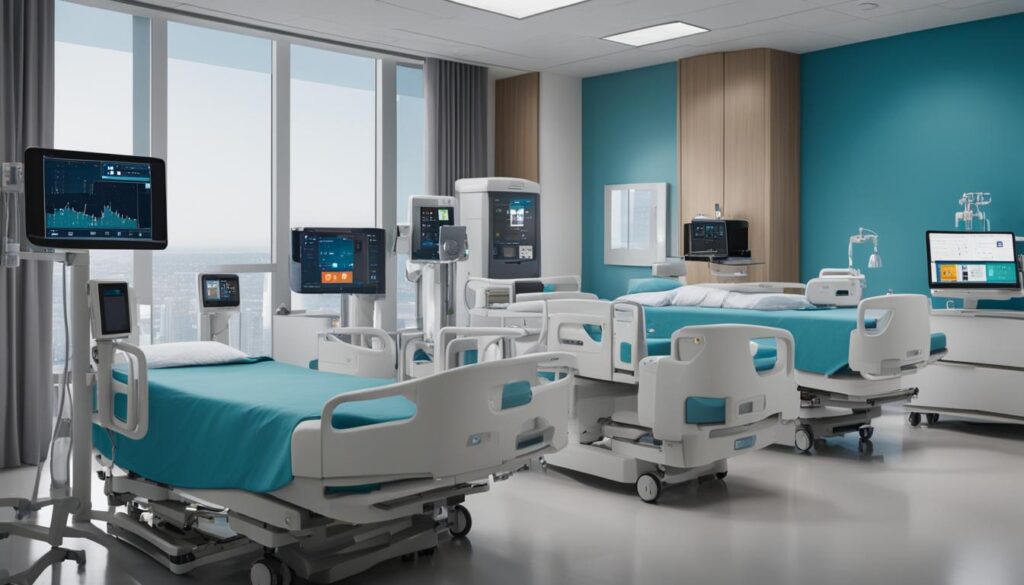
IoT technology has extended its reach beyond patient care and treatment processes to the management of hospital infrastructure and home care. The integration of IoT devices and systems enables efficient and automated control of various aspects of healthcare facilities and supports independent living for individuals in their homes.
In hospitals, smart building systems play a crucial role in infrastructure management. These systems utilize IoT technology to control lighting, heating, and cooling, creating a comfortable environment for patients. By automatically adjusting these factors based on occupancy and ambient conditions, smart building systems contribute to patient comfort and overall energy efficiency.
Home automation systems offer a range of benefits for elderly or disabled individuals who require ongoing care. By integrating healthcare devices with IoT technology, these systems enable independent living and remote monitoring. IoT-powered home automation allows for real-time monitoring of vital signs and tracking medication adherence, ensuring the well-being of patients in their own homes.
The seamless integration of IoT in hospital and home automation enhances patient comfort, promotes efficient management of healthcare facilities, and supports individuals in maintaining an independent lifestyle.
Conclusion
The integration of IoT in healthcare is revolutionizing the industry, transforming it into a patient-centric, efficient, and accessible domain. By harnessing the power of IoT devices and systems, healthcare providers can engage in real-time patient monitoring, create personalized treatment plans, and optimize operational efficiency in medical facilities. This transformative technology has the potential to greatly improve patient outcomes and enhance the overall quality of care.
While challenges such as data security and interoperability need to be addressed, the future of IoT in healthcare is promising. By embracing IoT innovations, the healthcare industry can deliver more effective and efficient services, ultimately leading to improved patient outcomes. Patient-centric care becomes the focus as healthcare providers can continuously monitor and adjust treatment plans, resulting in personalized and optimized care.
IoT in healthcare is the catalyst for a profound healthcare transformation. By leveraging IoT solutions, healthcare organizations can enhance patient care, streamline processes, and reduce costs. The seamless integration of IoT devices and systems enables real-time data collection, analysis, and intervention, facilitating timely and proactive healthcare interventions. The future holds tremendous potential as IoT continues to shape the healthcare landscape, ultimately leading to improved outcomes and a more patient-centric approach to healthcare delivery.
Also Refer : Audio Visual Technology Trends & Insights 2024
FAQs
Q: What is IoT in Healthcare?
A: IoT in healthcare refers to the use of internet of things connected devices and sensors to collect and exchange health data. These devices are used to monitor patients, track medication inventory, and streamline healthcare operations.
Q: How is IoT revolutionizing the healthcare industry?
A: IoT is transforming the healthcare industry by enabling healthcare providers to monitor patients in real time, track medical equipment and inventory, and improve efficiency in healthcare operations.
Q: What are the benefits of using IoT in healthcare?
A: IoT helps in reducing healthcare costs, improving patient outcomes, and enhancing the overall quality of healthcare services internet of medical things monitoring system. It also enables proactive and remote monitoring of patients’ health conditions.
Q: What are some examples of IoT applications in healthcare?
A: IoT applications in healthcare include the use of IoT medical devices, connected medical devices for patient monitoring, and IoT systems for managing healthcare information technology.
Q: How are IoT devices used in the healthcare sector?
A: IoT sensor devices are used to health monitor patient health, track medical application inventory, ensure medication compliance, and facilitate data exchange between healthcare professionals and patients.
Q: How does IoT technology help healthcare providers?
A: IoT technology helps healthcare providers by enabling remote monitoring of patients, improving operational efficiency, and enhancing the delivery of healthcare services through data-driven insights.
Q: What is the role of IoT in enabling connected medical devices?
A: IoT plays a crucial role in enabling connected medical devices to exchange health data, remotely monitor patients, and facilitate seamless integration of healthcare technology.
Q: How is IoT contributing to healthcare information technology?
A: IoT is contributing to healthcare information technology by streamlining data management, enhancing interoperability of medical devices, and enabling secure transfer of health information.
Q: What can IoT devices do to improve healthcare operations?
A: IoT devices can help in optimizing inventory management, enhancing patient monitoring, and improving resource allocation in healthcare operations, leading to greater efficiency and cost savings.
Q: How is IoT expected to impact the healthcare market?
A: The healthcare IoT market is expected to experience significant growth, with IoT devices contributing to the improved quality of care, enhanced patient outcomes, and increased efficiency in healthcare delivery.
Source Links
- https://iotbusinessnews.com/2023/10/14/44345-revolutionizing-healthcare-the-internet-of-things-iot-in-healthcare/
- https://www.linkedin.com/pulse/revolutionizing-care-impact-iot-healthcare-industry-rakesh-thakor-yuryf
- https://www.peerbits.com/blog/internet-of-things-healthcare-applications-benefits-and-challenges.html









